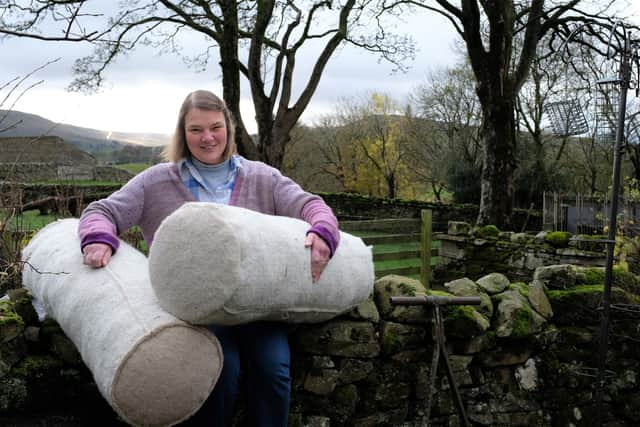Sheep fleeces are being used in a pilot project on peat restoration in The Dales and North York Moors
Ruth Lindsey, a Bradfordian settled in Hardraw in Upper Wensleydale, is making woollen logs for use in peatland restoration.
Currently, vast amounts of imported coconut husk, manufactured into coir logs, are being placed across eroding gullies on degraded peatlands in Yorkshire and Cumbria as the logs stop heavy rain washing away the exposed peat, allowing mosses and other vegetation to grow back.
Advertisement
Hide AdAdvertisement
Hide AdA small scale trial of 30 woollen logs is taking place this winter at Fleet Moss in the Yorkshire Dales, as well as at two peatland sites in the North York Moors National Park. It’s hoped the wool will prove to be an effective alternative to coir.


The Yorkshire Dales National Park Authority administers Defra’s three-year Farming in Protected Landscapes programme in the Yorkshire Dales National Park. So far it has awarded just over one million pounds in grants to 86 businesses. More than a million pounds remains in the pot and farmers are being invited to apply for it.
Mrs Lindsey, who is trading as Natural Dales Wool Products, said she began to think about new uses for wool when she learned from a farming friend that Swaledale fleeces, which are coarse and short stapled, were fetching only 8 pence a kilogram.
She said: “It costs between £1.20 and £1.50 to pay someone to clip a sheep. If you get two kilos of wool from a Swaledale ewe you’re doing well. Then the farmers have to transport it to the British Wool depots at Marrick or Ingleton. So they are making a massive loss. That’s why mountain wool is being burned or buried or left in barns.”
Advertisement
Hide AdAdvertisement
Hide AdShe said the idea to turn fleeces into logs came to her after reading an article on peatland restoration.
She added: “For the past two years four farms have given me their wool, although in future I want to be able to pay for it. This year the fleeces were baled at Thwaite Bridge Farm and put into wool sheets and taken Salts Mill [in Saltaire] to be stored. They will soon be going to Dewsbury for scouring.”
Once scoured the wool will be stuffed into one metre-long logs made from felt. Mrs Lindsey is also selling the felt at a local business in Hawes for use as a mulch around trees or in garden beds.
She said: “From start to finish the wool travels 145 miles, whereas with coconut fibre it’s travelled thousands of miles. The amount of wool that could be used on bogs is astonishing.
Advertisement
Hide AdAdvertisement
Hide Ad"But there are a lot of unknowns. We don’t whether the wool fibre will last as long as the coconut fibre. We don’t know whether it’s going to hold the water back. That’s why we’ve got the trials going. The idea is to support the local community by using local wool for local peat.
“We want to be able to pay 50 pence per kilo of wool. That still wouldn’t cover the cost of employing a shearer but it would be getting there.”
The Member Champion for the Natural Environment at the Yorkshire Dales National Park Authority, Mark Corner, said: "The grant for Natural Dales Wool Products to test the idea of whether wool can be used in peatland restoration is exciting and eye-catching, and it is one of the more unusual awards.”
